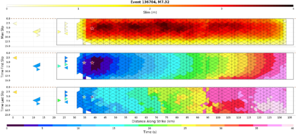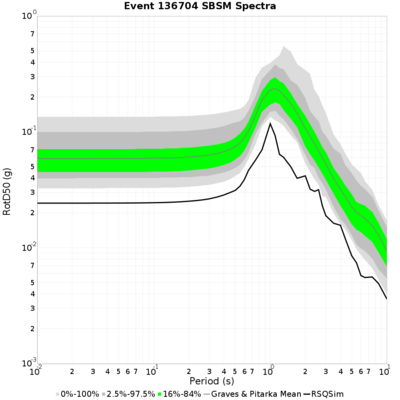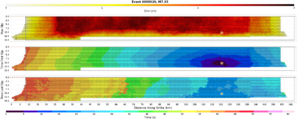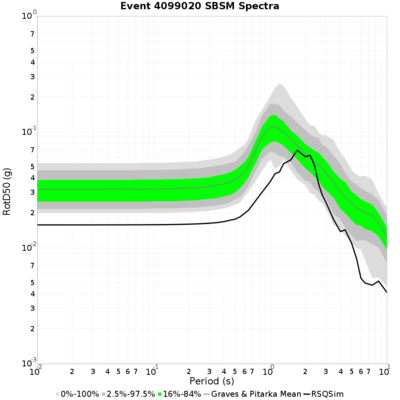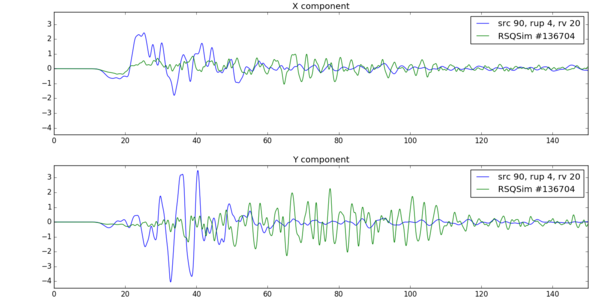Difference between revisions of "RSQSim Rupture Ground Motion Comparisons"
| (2 intermediate revisions by the same user not shown) | |||
| Line 14: | Line 14: | ||
* Gray, area: 2.5-97.5% GP percentiles | * Gray, area: 2.5-97.5% GP percentiles | ||
* Light gray, area: Min/max range across all GP simulations | * Light gray, area: Min/max range across all GP simulations | ||
| + | NOTE: y-axis ranges vary for each plot | ||
{| | {| | ||
! Catalog/Rup | ! Catalog/Rup | ||
| Line 23: | Line 24: | ||
| rundir2194_long | | rundir2194_long | ||
Rupture 136704, M7.32 | Rupture 136704, M7.32 | ||
| − | SAF Mojave, S-E | + | SAF Mojave, S-E hypo |
| RSQSim: 1.32 km^2 triangles | | RSQSim: 1.32 km^2 triangles | ||
GP: 1.16km x 1.16km square | GP: 1.16km x 1.16km square | ||
| Line 32: | Line 33: | ||
| JG UCERF3 Million Elements | | JG UCERF3 Million Elements | ||
Rupture 4099020, M7.35 | Rupture 4099020, M7.35 | ||
| − | SAF Mojave, S-E | + | SAF Mojave, S-E hypo |
| RSQSim: 0.23 km^2 triangles | | RSQSim: 0.23 km^2 triangles | ||
GP: 0.48km x 0.48km square | GP: 0.48km x 0.48km square | ||
| Line 39: | Line 40: | ||
| [[File:SBSM_spectra_compare_event_4099020.png|400px|thumb|San Bernardino]] | | [[File:SBSM_spectra_compare_event_4099020.png|400px|thumb|San Bernardino]] | ||
|} | |} | ||
| + | |||
| + | == CyberShake Comparisons == | ||
| + | Scott Callaghan as also run Ruptupre 136704 (top, above) through previously computed CyberShake SGTs for a site in Wittier Narrows and compared to the most similar CyberShake Rupture Variation (also generated with GP 2015) | ||
| + | |||
| + | [[File:WNGC_3854_rsq136704_vs_s90_r4_rv20.png|600px|thumb|CyberShake Seismograms]] | ||
Latest revision as of 18:20, 28 September 2017
Contents
Broadband Platform Comparisons
This exercise uses the SCEC Broadband Platform to compute seismograms and calculate RotD50 spectra from RSQSim ruptures in a 1-D velocity structure. We then compute the RSQSim results with those from suites of kinematic rupture models with the same grid spacing, rupture surface, and hypocenter using the Graves & Pitarka (2015) rupture generator.
Implementation Notes
RSQsim ruptures can be on very complex surfaces, while the BBP requires a planar representation. For this comparison, we choose simple relatively planar ruptures on the Mojave section of the San Andreas, which should minimize these differences.
Also, Graves & Pitarka uses a regular grid, while the RSQSim models considered use a triangular mesh. I compute an effective grid spacing to use in RSQSim as the square root of the average area of all triangles included in the RSQSim rupture, so the sources in the GP kinematic ruptures will have the same area as the average RSQSim triangle.
Results
Spectra plot legend:
- Black, solid line: RSQSim
- Gray, solid line: Mean GP
- Green, area: 16-86% GP percentiles
- Gray, area: 2.5-97.5% GP percentiles
- Light gray, area: Min/max range across all GP simulations
NOTE: y-axis ranges vary for each plot
| Catalog/Rup | Spacing | Rupture Image | USC RotD50 Spectra | SBSM RotD50 Spectra |
|---|---|---|---|---|
| rundir2194_long
Rupture 136704, M7.32 SAF Mojave, S-E hypo |
RSQSim: 1.32 km^2 triangles
GP: 1.16km x 1.16km square |
|||
| JG UCERF3 Million Elements
Rupture 4099020, M7.35 SAF Mojave, S-E hypo |
RSQSim: 0.23 km^2 triangles
GP: 0.48km x 0.48km square |
CyberShake Comparisons
Scott Callaghan as also run Ruptupre 136704 (top, above) through previously computed CyberShake SGTs for a site in Wittier Narrows and compared to the most similar CyberShake Rupture Variation (also generated with GP 2015)
